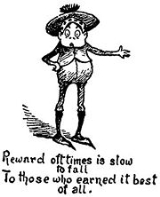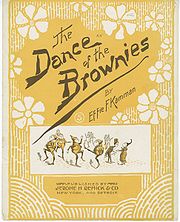
The Brownies
Encyclopedia

Canada
Canada is a North American country consisting of ten provinces and three territories. Located in the northern part of the continent, it extends from the Atlantic Ocean in the east to the Pacific Ocean in the west, and northward into the Arctic Ocean...
illustrator
Illustrator
An Illustrator is a narrative artist who specializes in enhancing writing by providing a visual representation that corresponds to the content of the associated text...
and author
Author
An author is broadly defined as "the person who originates or gives existence to anything" and that authorship determines responsibility for what is created. Narrowly defined, an author is the originator of any written work.-Legal significance:...
Palmer Cox
Palmer Cox
Palmer Cox was a Canadian illustrator and author, best known for The Brownies, his series of humorous verse books and comic strips about the mischievous but kindhearted fairy-like sprites. The cartoons were published in several books, such as The Brownies, Their Book...
, based on names and elements from Celtic mythology
Celtic mythology
Celtic mythology is the mythology of Celtic polytheism, apparently the religion of the Iron Age Celts. Like other Iron Age Europeans, the early Celts maintained a polytheistic mythology and religious structure...
and traditional highland Scottish stories told to Cox by his grandmother. Illustrations with verse aimed at children, The Brownies was published in magazines and books during the late 19th century and early 20th century. The Brownie characters became famous in their day, and at the peak of their popularity were a pioneering name brand within merchandising
Merchandising
Merchandising is the methods, practices, and operations used to promote and sustain certain categories of commercial activity. In the broadest sense, merchandising is any practice which contributes to the sale of products to a retail consumer...
.
Characters and story
Not unlike fairiesFairy
A fairy is a type of mythical being or legendary creature, a form of spirit, often described as metaphysical, supernatural or preternatural.Fairies resemble various beings of other mythologies, though even folklore that uses the term...
and goblin
Goblin
A goblin is a legendary evil or mischievous illiterate creature, a grotesquely evil or evil-like phantom.They are attributed with various abilities, temperaments and appearances depending on the story and country of origin. In some cases, goblins have been classified as constantly annoying little...
s, Brownies are imaginary little sprites
Sprite (creature)
The term sprite is a broad term referring to a number of preternatural legendary creatures. The term is generally used in reference to elf-like creatures, including fairies, and similar beings , but can also signify various spiritual beings, including ghosts. In Eoin Colfer's Artemis Fowl books,...
, who are supposed to delight in harmless pranks and helpful deeds. Never allowing themselves to be seen by mortal eyes, they are male, drawn to represent many professions and nationalities, all mischievous members of the fairy world whose principal attribute is helping with chores while a family sleeps.
Publication history
The first appearances of Brownie characters in a print publication took place in 1879, but not until the February, 1881 issue of Wide Awake magazine were the creatures printed in their final form. The first proper story, The Brownies' Ride, appeared in the February 1883 issue of the children's periodical St. Nicholas MagazineSt. Nicholas Magazine
St. Nicholas Magazine was a popular children's magazine, founded by Scribner's in 1873. The first editor was Mary Mapes Dodge, who continued her association with the magazine until her death in 1905. Dodge published work by the country's best writers, including Louisa May Alcott, Francis Hodgson...
.
Published in 1899, The Brownies Abroad is considered the first Brownie comic strip
Comic strip
A comic strip is a sequence of drawings arranged in interrelated panels to display brief humor or form a narrative, often serialized, with text in balloons and captions....
, though it didn't utilise speech balloons until the publication The Brownie Clown of Brownie Town of 1908. From 1903, The Brownies appeared as a newspaper Sunday strip
Sunday strip
A Sunday strip is a newspaper comic strip format, where comic strips are printed in the Sunday newspaper, usually in a special section called the Sunday comics, and virtually always in color. Some readers called these sections the Sunday funnies...
for several years.
The first compilation, The Brownies, Their Book, was published in 1887, followed by 16 books in the series until the last in 1918. Palmer Cox died in 1924.

Merchandising
Beyond print publication, The Brownies was at least twice adapted to stage plays. With the rise in popularity of the Brownie characters, these were used in many venues of merchandising, such as games, blocks, cards, dolls, calendars, advertisements, package labels, mugs, plates, flags, soda pop, a slot machine, a bagatelle game and so forth. George EastmanGeorge Eastman
George Eastman was an American innovator and entrepreneur who founded the Eastman Kodak Company and invented roll film, helping to bring photography to the mainstream...
applied the brand name in promotion of Kodak's "Brownie Camera
Brownie (camera)
Brownie is the name of a long-running and extremely popular series of simple and inexpensive cameras made by Eastman Kodak. The Brownie popularized low-cost photography and introduced the concept of the snapshot. The first Brownie, introduced in February, 1900, was a very basic cardboard box camera...
", but Palmer Cox reportedly never received any money for the commercial use of his work.
Sources
Footnotes
External links
- "The Brownies at School" from The Brownies: Their Book The Baldwin Library of Historical Children's Literature
- Palmer Cox and The Eastman Kodak Brownie camera

